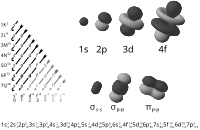
Photo from wikipedia
Coupling between charge and spin, and magnetoelectric effects more generally, have been an area of great interest for several years, with the sought-after ability to control magnetic degrees of freedom… Click to show full abstract
Coupling between charge and spin, and magnetoelectric effects more generally, have been an area of great interest for several years, with the sought-after ability to control magnetic degrees of freedom via charge currents serving as an impetus. The orbital Edelstein effect (OEE) is a kinetic magnetoelectric effect consisting of a bulk orbital magnetization induced by a charge current. It is the orbital analogue of the spin Edelstein effect in spin-orbit coupled materials, in which a charge current drives nonzero electron spin magnetization. The OEE has recently been investigated in the context of Weyl semimetals and Weyl metals. Motivated by these developments, we study a model of electrons without spin-orbit coupling which exhibits line nodes that get gapped out by via symmetry breaking due to an interaction-induced charge density wave order. This model is shown to exhibit a temperature dependent OEE, which appears due to symmetry reduction into a gyrotropic crystal class.
Journal Title: Physical Review B
Year Published: 2019
Link to full text (if available)
Share on Social Media: Sign Up to like & get
recommendations!